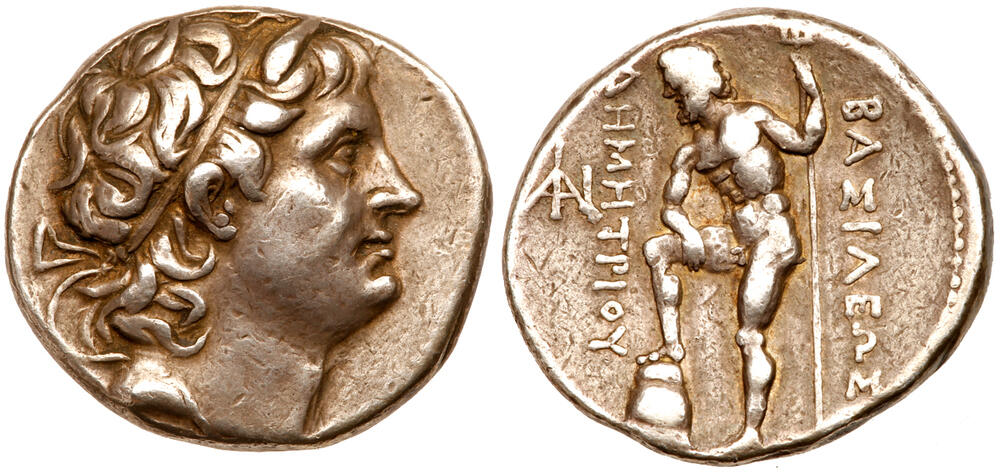H 131 - Uncertain mint, silver, tetradrachm, 292-287 BC
From SILVER
292 - 287 Silver 0 kg
Description
| ObverseInscription or printing placed on the obverse.: | Diademed and horned head of Demetrios I right. |
| ReverseInscription or printing placed on the reverse.: | ΒΑΣΙΛEΩΣ ΔHMΗΤΡΙΟΥ (Greek). |
Mint and issuing power
| MintIdentifies the place of manufacture or issue of a numismatic object.: | Ancient regionAncient region.: | Modern countryModern country: | AuthorityIdentifies the issuing power. The authority can be "pretended" when the name or the portrait of X is on the coin but he/she was not the issuing power. It can also be "uncertain" when there is no mention of X on the coin but he/she was the issuing power according to the historical sources: | Demetrius I Poliorcetes (Antigonid king, 294-283 BC) |
Chronology
| FromIdentifies the initial date in a range assigned in a numismatic context. | 292 | toIdentifies the final date in a range assigned in a numismatic context.. | 287 | PeriodTime period of the numismatic object.: Hellenistic 323-30 BC |
Physical description
| MetalThe physical material (usually metal) from which an object is made.: | Silver |
DenominationTerm indicating the value of a numismatic object. Examples: tetradrachm, chalkous, denarius.: | tetradrachm |
StandardStandard.: | |
| Mode weightMode of the weights of numismatic objects (in grams).: | 16,80-99<ul><li>No units of measurement were declared for this property.</li> <!--br--><li>",80-99" is not declared as a valid unit of measurement for this property.</li></ul> |
Image

H131 Demetrios Poseidon.jpeg [1]
References
| Die study referencePublication of the study: | E. T. Newell1E. T. Newell, The Coinages of Demetrios Poliorcetes, Londres, 1927. | ||
| Coin series referenceReference to coin series study: | |||
Obverse dies distribution
| FrequencyFrequency of specimen in distribution. ᵖ | Number of obversesNumber of obverse dies. ᵖ (o) | % (o) | Number of coinsNumber of coins. (n) | % (n) | Die nameName(s) of the die(s). |
| 1 | 32 | 38.1 | 32 | 14.75 | |
| 2 | 18 | 21.43 | 36 | 16.59 | |
| 3 | 16 | 19.05 | 48 | 22.12 | |
| 4 | 7 | 8.33 | 28 | 12.9 | |
| 5 | 3 | 3.57 | 15 | 6.91 | |
| 6 | 3 | 3.57 | 18 | 8.29 | |
| 7 | 2 | 2.38 | 14 | 6.45 | |
| 8 | 2 | 2.38 | 16 | 7.37 | |
| 10 | 1 | 1.19 | 10 | 4.61 | |
| Total | 84 of 84 | 100 | 217 of 217 | 99.99 |
Reverse dies distribution
no distribution is available
Quantification
| Number of obversesNumber of obverse dies. ᵖ (o) | 84 | Number of singletons (o1)The number of singleton coins. ᵖ | 32 |
| Number of reverse diesNumber of reverse dies. (r) | 159 | Number of coinsNumber of coins. (n) | 217 |
| Coins per obverse dieNumber of coins per obverse die. (n/o) | 2.58 | Coins per reverse dieNumber of coins per reverse die. (n/r) | 1.36 |
| Reverse per obverse ratioRatio of obverse dies divided by reverse dies. (r/o) | 1.89 | Percentage of singletons (o1)number of coins (n) divided by the number of singletons (o1) ᵖ | 38.1 % |
| Original number of dies (O) (Carter 1983 formula)The estimation of the number of coins according to Carter 1983 ᵖ | 114.96 | Coins struck if 20,000 as average productivity per dieCoins made if the average productivity for obverses (according to Carter) is 20,000. ᵖ | 2,299,200 |
| Original number of dies (O) (Esty 2011 formula)The estimation of the number of coins according to the singleton formula in Esty 2011 ᵖ (O) | 137.05 | Survival rate if 20,000 as average productivity per dieSurvival rate if average productivity is 20,000. ᵖ | 0.00009 |
| Coverage (o = % of O) (Esty 1984 formula)Esty 1984 - coverage (% of O) ᵖ (o = % of O) | 85.25% | Die productivity if survival rate 1/2,000Average productivity if survival rate is 1/2,000. ᵖ | 3,775.23 |
| Weight of silver (in kg) if 20,000 coins per die (O = Carter formula)Carter 1983 * Median weight * 20000 (*10 if gold or electrum) ᵖ | 0 kg <br /> 0 kg | Die productivity if survival rate 1/5,000Average productivity if survival rate is 1/5,000. ᵖ | 9,438.07 |
Remarks